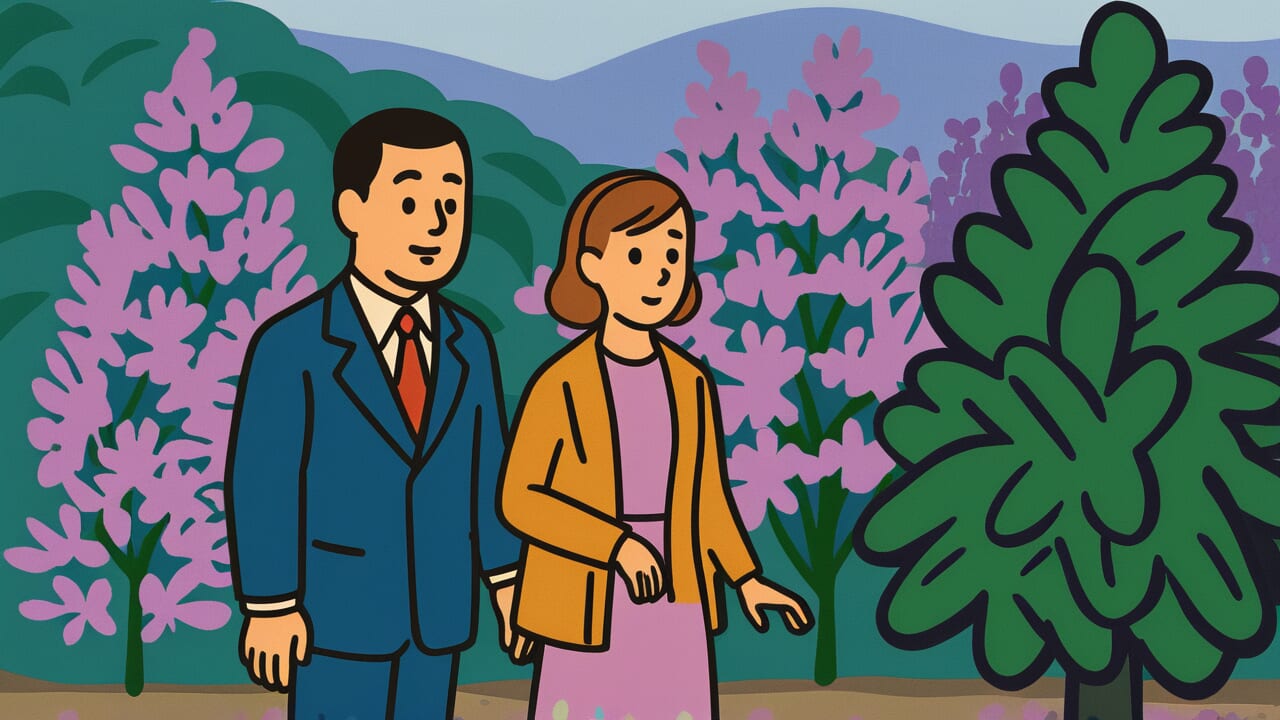How to Read “Men are pines, women are wisterias”
Otoko wa matsu, onna wa fuji
Meaning of “Men are pines, women are wisterias”
This proverb expresses a traditional view of gender roles. Men should be strong and upright like pine trees, while women should be soft and beautiful like wisteria vines.
Just as pines stand straight through wind and snow, men were expected to show strength and firmness in the face of hardship. They should not bend or break under difficult circumstances.
Meanwhile, wisteria vines lean on other trees while blooming with elegant flowers. Women were expected to show flexibility and beauty in the same way.
This proverb was mainly used in teaching children and giving life advice. It compared the qualities expected of each gender to the characteristics of these plants.
Today, many people view this saying critically as a fixed gender stereotype. However, historically it was widely recognized as expressing the ideal image of men and women in Japanese society.
Origin and Etymology
The exact source of this proverb is unclear. It likely emerged from the combination of traditional Japanese views about plants and gender roles.
Pine trees have long been honored in Japan as the “king of evergreens.” They keep their green color even in harsh winters. They take root even on rocky cliffs and grow straight toward the sky.
This appearance became a symbol of unyielding spirit and strength. Wisteria, on the other hand, is a climbing vine that blooms with elegant purple flower clusters in spring.
It grows by wrapping around other trees. Its soft curves and splendor represented feminine grace in Japanese aesthetics.
Records show that expressions comparing ideal gender traits to plants were widely used during the Edo period. Samurai society demanded strength and unwavering posture from men.
Women were expected to show gentle and beautiful behavior. Against this social background, the contrasting characteristics of pines and wisterias became the perfect metaphor for expressing gender ideals.
The strong visual imagery of these plants made this proverb easy to understand and memorable.
Interesting Facts
In Japanese culture, the pine is one of the “Three Friends of Winter” along with bamboo and plum. It symbolizes noble character.
People treasure pines in New Year decorations and bonsai. This comes from respect for their unchanging strength.
Wisteria flowers have been loved by nobles since the Heian period. The Fujiwara clan even used wisteria in their family crest.
There was a custom of composing poetry under wisteria trellises. This flower has captured Japanese hearts as a symbol of elegance.
Usage Examples
- My grandfather raised us grandchildren saying “Men are pines, women are wisterias,” but looking back now, it feels like a teaching from another era
- I heard that in traditional households, the idea that “Men are pines, women are wisterias” remained deeply rooted
Universal Wisdom
This proverb has been passed down through generations because it contains universal wisdom about role division in human society. It teaches us to make use of different characteristics.
The ancestors who chose the contrasting plants of pine and wisteria had remarkably sharp observation skills.
Pines stand alone and grow toward the sky by their own power. Wisteria lean on other trees and bloom beautiful flowers while receiving support.
This contrast shows more than just the surface difference between strength and softness. It demonstrates different philosophies of living: independence versus cooperation, linear growth versus curved development.
Human society functions when people with various characteristics complement each other. Society cannot exist with only one set of values.
Strength alone makes things rigid. Softness alone cannot maintain form. This proverb may be teaching the importance of recognizing diverse ways of being through familiar plants.
However, it is also true that this wisdom has been used to impose fixed roles on specific genders. In reality, strength and flexibility are qualities anyone can possess.
They should be used depending on the situation. Perhaps the true wisdom this proverb shows lies in recognizing the value of diversity.
When AI Hears This
Pine trunks are strong against vertical compression forces. They are structured to withstand their own weight and loads from above.
Wood engineering experiments show that pine wood reaches compressive strength of about 40 megapascals. That equals 400 kilograms of force per square centimeter.
Wisteria vines, meanwhile, specialize in tensile strength. At the same thickness, they have several times the tensile strength of pine. They bend flexibly but resist being torn apart with surprising force.
In architecture, columns mainly bear compression forces while beams bear tensile forces. Imagine a suspension bridge, for example.
The vertical towers withstand compression like pines. The cables receive tensile forces like wisteria. Neither alone can make the structure work.
What’s interesting is that combining materials with different mechanical properties allows us to support large spaces impossible with either alone.
This proverb is fascinating because of how precisely it chose pine and wisteria. Not bamboo or cedar, but pine. Not kudzu, but wisteria.
This combination most clearly expresses the contrasting mechanical properties of compression and tension materials. Ancient people did not know structural mechanics theory.
Yet through observing natural materials, they intuitively understood the essence of systems where things with different strengths support each other.
Lessons for Today
What this proverb teaches modern people is the importance of flexible thinking free from stereotypes. True, it shows traditional gender roles.
But what we should learn is not “which is better, pine or wisteria.” It’s the perspective that “different characteristics each have value.”
You have both pine-like strength and wisteria-like flexibility within you. When facing difficulties, stand firm like a pine.
In relationships, lean in flexibly like wisteria. People who can make such adjustments are truly mature.
What matters is demonstrating your diverse qualities according to the situation, regardless of gender or position. Sometimes strong, sometimes soft.
Sometimes independent, sometimes cooperative. Such flexibility is the wisdom for surviving in our complex modern society.
When we reinterpret this proverb as a trigger for recognizing human diversity, new value emerges.



Comments